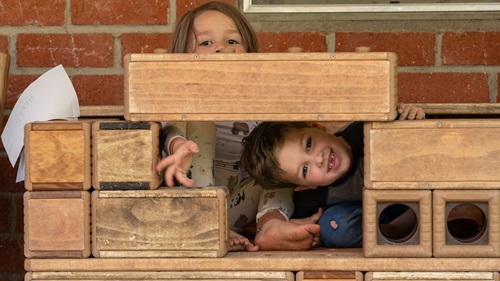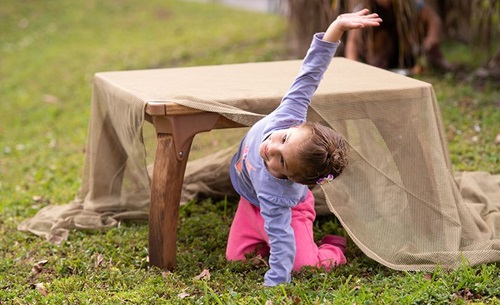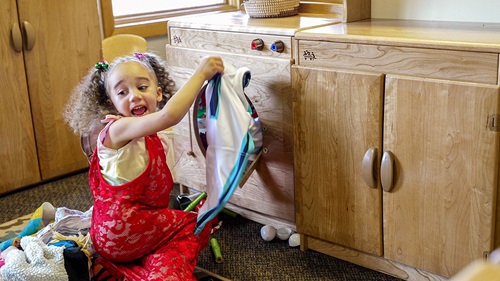Promoting Collaborative Play in the Outdoors
| April 2025Imagine the last time you worked collaboratively with others. If you’re part of a teaching team in early education, this is likely a regular occurrence. What supports the dynamic of working well with others? Is there a low-stress environment that promotes flow and open-ended thinking? Do you have uninterrupted time to explore ideas together?
Children need similar conditions to play collaboratively with each other. Participating in collaborative play helps children develop important skills in cognitive, social, and emotional areas. Working in collaboration with others promotes language development, problem-solving, and creativity. It also helps children build trust and empathy with their peers, as they learn the value of teamwork. Finally, it allows for opportunities to develop self-confidence in the sharing of ideas and to manage feelings such as disappointment or frustration.
If you want to promote this type of play in your outdoor space, it’s important to think about the ways the children will be using the space. Children are much more likely to welcome others into their play when they are given opportunities to do so freely and uninterrupted by external interference, whether that’s adults stepping in with rules, limited curriculum materials, or a space that restricts a child’s freedom to make choices. The “yes” a child says to a peer starts in the “yes” created by the classroom.
Intentional outdoor design provides children with spaces that are created specifically for them, where they feel they belong and are inspired to play together. There are three parts to consider when creating an outdoor space that encourages collaborative play: a “yes” environment, abundant open-ended materials, and the role of the teacher.
Creating a ‘Yes’ Environment Outside
First, it’s important to create a “yes” environment, one in which children are free to focus on what they can do, rather than worrying about what they can’t. If you find yourself saying “no” all the time and your outdoor space stresses you out, consider where you can make changes. Are there too few shovels and pails in the sand area? Do you limit where children can use tricycles? Is climbing on the outdoor furniture not allowed, but the children do it anyway?
Play yards are an ideal space to let children take reasonable gross motor risks. When children want to create an obstacle course for the tricycles, saying yes gives opportunities for children to come together on how to make it happen, with adult guidance to ensure safety and avoid conflict. If children want to climb in less appropriate places, like the bookshelf or block building table, is there a play structure they can be redirected to? It’s the perfect opportunity for the teacher to invite children to come up with creative ways to make the structure more interesting to climb on, maybe with ropes for pulling themselves up or soft tumbling mats to fall on.
Involving children in this way also encourages them to say yes to each other. As you allow them to collaborate with you in how the outdoor space is used, they will begin to reach out to each other, for ideas or to participate in bringing over materials. The excitement and enthusiasm of one can quickly become that of many children—all because you avoided saying no and gave them a chance to run with an idea.
Provide Abundant Open-Ended Materials
When children are fully engaged in play, having access to plenty of materials supports their desire to continue what they’re doing, even if other children want to join. A lack of shovels, paper towel tubes, paint brushes, or sticks can lead to children hoarding what they have, for fear other children might take them away. Offering more than enough in each area of your outdoor space encourages the children to invite others to play with them.
Recycled and natural materials are best for this. They can be collected by the children or in collaboration with families, then made available to be used in whatever way the children want. Cardboard tubes become telescopes, slides for rocks or marbles, or entire cityscapes. Acorns and pinecones become miniature pets, money at a grocery store, or buried treasures. When offered in great abundance, children will be more likely to involve their peers in their play because they know there’s more than enough to go around.
Refine The Role of the Teacher
Teachers design and set up the outdoor space, make sure routines happen, ensure safety, and help negotiate conflict. It’s also important that we step back and allow opportunities for the children to have autonomy and independence. When we’re constantly hovering, making suggestions for what to do and interrupting to correct behavior, children do not have the chance to deeply focus on their play.
When they’re constantly interrupted, children might feel like their play is being limited. Once this happens, they might become more likely themselves to limit other children from joining in. Finding ways to include other children starts to become just another interruption to play. As with materials that are scarce, children will also hoard their time from peers, if they think working in collaboration means they don’t get to play the way they wish.
Of course, it’s also our job as teachers to encourage inclusivity. We get involved when there’s a communication breakdown between children or a conflict arises. Striking the balance between avoiding too many interruptions and stepping in to foster inclusivity is a delicate task. Laying the groundwork of expectations at circle time or taking other opportunities to discuss what play between peers should look like can help when issues arise in the play yard. Asking questions such as, “How can you include this new child into your game?” rather than telling children what to do can help children feel empowered to bring other children in, instead of resentful.
Put It All Together
An outdoor space designed for “yes” provides ample opportunities for children to play with others and work together, knowing there’s plenty of time, materials, and teacher support.
For example, the large hollow block area in the outdoor classroom offers a prime opportunity for collaborative play to thrive. To set up this area, make sure blocks are located with plenty of room for children to create wide, complex structures. Children will naturally begin to work together in their building, whether that’s on a single structure or on individual structures that end up bumping up against one another. Setting out boxes and baskets of additional curriculum materials, such as cars, balls, or paper towel tubes, extends the children’s construction play. When there is an abundance of these items, children will generally avoid bickering over who gets what and instead cooperate toward an agreed upon goal. Meanwhile, teachers remain nearby—not to interrupt by enforcing rules, necessarily, but to guide children through conflicts and ask questions about the play children are doing.
By cultivating this kind of environment, teachers help children develop trust with their caregivers and peers, allowing the kids time to focus on play and the connections they form with one another. As a teacher by knowing when to step back and when to step in, we promote open-ended thinking and encourage children to say yes more often themselves. With these components in place, we lay the groundwork for children to play well together and prepare them for a lifetime of collaborative interactions with others.











